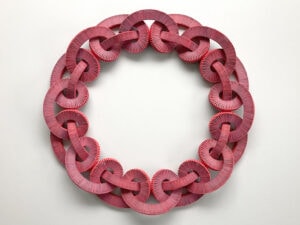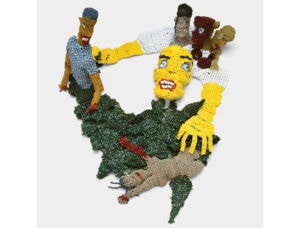Fossicking around the internet for information about SOFA Chicago, the big American applied arts fair held on November 5–7, 2010, I came across this report by Lauren Viera in the Chicago Tribune newspaper.
Fossicking around the internet for information about SOFA Chicago, the big American applied arts fair held on November 5–7, 2010, I came across this report by Lauren Viera in the Chicago Tribune newspaper.
Under the not very promising heading ‘Interior design meets outsider art’ Viera wrote: ‘To every genre of visual art, there is a season. In the spring, art aficionados flock to Artropolis (30-year-old Art Chicago reincarnated for the 21st century) to peruse booth after booth of paintings, drawings and mixed-media sculpture. (The Merchandise Mart International Antiques Fair is tied to Artropolis, too, but is out of sight and mostly out of mind on its own floor in that massive building.) In the fall, three-dimensional art and wearable-art fans sashay through the booths at SOFA, the International Exposition of Sculptural Objects & Functional Art, to coo over art glass, handmade furniture and artisan jewelry, among other home pieces.’
Consider the language here. Fine arts viewers are aficionados, not fans, a subtle but important difference and they peruse the subject of their desire at Artropolis. The craft fans, in contrast, sashay (not walk) through SOFA and coo (not converse) over objects that are part of decorating the domestic environment.
Of course, there isn’t much new in this kind of sneering. It doesn’t take a journalist from the Tribune – which, if we wanted to give Viera a taste of her own medicine, we might note is not exactly the New York Times – to let craft know it is the unpopular kid at Visual Culture High School. No friends and, according to Viera, more than a little effeminate.
What caught my interest is the redemptive moment in Viera’s narrative. SOFA, which, as Viera charmingly puts it, ‘we seldom cover in these pages as its dealers tend to be more closely associated with home decor than visual art,’ is now worthy of the attention of fine arts aficionados because, for the first time, it is showing outsider or self-taught art amidst all the home- and body-decorating objects. Under the auspices of Intuit, The Center for Intuitive and Outsider Art, sixteen dealers of outsider art will show their wares at the fair – safely ‘sanctioned off in a space to themselves, accessible via various entry points within SOFA’s sea of more than 70 dealers.’
In her relief that she and other mavens of fine art won’t have to spend time with the decor, Viera misses some major ironies in this situation – and not just the obvious one that the outsider art in question doesn’t appear to be either applied arts or craft. There is, for example, the irony that outsider art is to fine art what craft is to fine art – the unpopular kid who’s just too weird to be accepted. It might look good when compared to craft, but it suffers exactly the same kind of sneering that Viera reserves for craft. It is, just like craft, a subculture, a specialist group of makers, dealers, collectors and critics who exist uneasily within the larger ecosystem of the visual arts – and who spend just as much time worrying about the art historical hierarchy that keeps fine art in the number-one position. If this were an episode of Glee, the American TV show, both outsider art and craft would get a slushy in the face from the jocks and cheerleaders of fine art, even if it was being thrown for very different reasons.
And yet here is where it gets interesting, since as a classic example of the Other, outsider art is locked in a very special relationship with fine art. Outsider art is a space of fantasy for art proper, in which the fine arts can imagine their limits and play out their fears. As Joanne Cubbs argues, ‘Located far away from our pessimistic conversations about the death of originality and the end of authenticity, it is within [the world of the outsider] that we can play out our nostalgic and reactionary yearnings for a return to the uncorrupted sources of creativity itself.’ And there is more than a little of the iconoclastic posturing in fine art’s flirtation with outsider art. Cubbs again: ‘In many instances, Outsider Art is another manifestation of the common tendency within the art world to seek out and assimilate the marginalized as a means to reinforce and promote its own heretical or outsider posturing. Not surprisingly, the history of Outsider Art’s discovery is really an account of its appropriation by an art world and its repositioning as an imaginative pawn within that world’s ongoing aesthetic protests, iconoclastic struggles, and cultural debates.’
Viewed in this light, the presence of outsider art at SOFA is actually quite suggestive, since craft can be defined in exactly the same way as an Other, a place where fine art can articulate its deepest fantasies and find its limits. This, at least, is how Glenn Adamson defines craft in his book Thinking Through Craft. The marginalization of craft within fine art discourse proves something important, namely that ‘craft, as a cultural practice, exists in opposition to the modern conception of art itself.’ Better then not to define craft, or to try and map it as a set of things and instead allow it to be a conceptual limit that has been used to articulate what fine art is (and is not). As Adamson writes, ‘If craft is a frontier at which the aesthetic construct of modern art has often stopped short, then in that very stopping, art confronts its presumptions about itself.’ And isn’t it true that the recent turn to craft in contemporary art practice is just like fine art’s ‘discovery’ of outsider art – a kind of play in which art flirts with being bad through a dangerous encounter with its limits?
Ultimately, Viera’s dismissal of SOFA and craft starts to look like a kind of psychological mechanism to deal with her discomfort, to ensure her identity as an art aficionado – not to mention the object of her love – doesn’t just dissolve in the face of craft’s destabilizing effects. And while Viera can’t articulate the real reasons why, the presence of outsider art at SOFA is indeed noteworthy and quite a lot more theoretically productive than it first appears.




